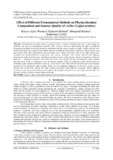Effect of Different Fermentation Methods on Physicochemical Composition and Sensory Quality of Coffee (Coffea arabica)

View/
Date
2017-06Author
Kinyua, A. W.
Kipkorir, R.
Mugendi, Beatrice J.
Kathurima, C.
Metadata
Show full item recordAbstract
Fermentation of coffee beans is primarily done to remove mucilage and can be done using two methods; dry and wet fermentation methods. This research aimed at determining the effect of different fermentation methods on physicochemical composition and the sensory quality of coffee. Coffee cherries were pulped and subjected to natural fermentation methods in different fermentation containers; plastic bucket, sack and cement tank. After fermentation, the parchment were washed and dried. The green coffee beans were for physicochemical composition and sensory attributes. The results showed that different fermentation methods did not have significant variations in most of the physico -chemical parameters analysed.
However, significant variations were observed in the levels of pH with the wet fermented coffee samples showing lower levels as compared to dry fermented samples. Sensory evaluation results showed that wet fermented coffee samples had better colour of green beans, least silver skin discoloration and overall quality compared to dry fermented coffee samples. There were no significant differences in the body, acidity, colour, flavour and overall class among the coffee samples fermented using different containers. Hence different containers used during fermentation do not affect coffee quality and processors can adopt materials that are cheaper to reduce expenses during coffee processing.
URI
http://hdl.handle.net/123456789/2751https://www.researchgate.net/publication/317658488_Effect_of_Different_Fermentation_Methods_on_Physicochemical_Composition_and_Sensory_Quality_of_Coffee_Coffea_arabica
Collections
- Journal Articles (PAS) [303]
